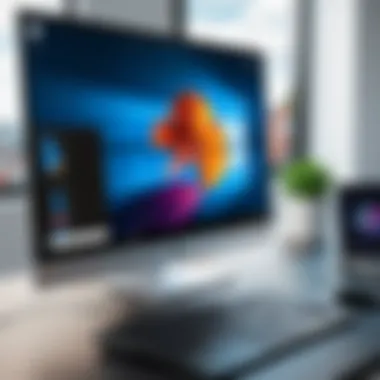Upgrade from Windows 10 Home to Professional Guide


Intro
Upgrading from Windows 10 Home to Windows 10 Pro can be a significant decision for users looking to unlock advanced features and capabilities. Many individuals and businesses question if such an upgrade is beneficial for their specific needs. This guide takes a comprehensive approach to understanding the upgrade process, the motivations behind it, and the implications for users, especially IT professionals.
As technology evolves, the demand for more powerful tools and features grows. Windows 10 Home offers a solid foundation for casual users, but Windows 10 Pro introduces additional functionalities that cater to professional and enterprise environments. Understanding these differences is crucial when considering the upgrade.
The following sections will break down the relevant aspects of upgrading, including performance metrics, usability, and user experience. This article seeks to provide valuable insights that inform both tech enthusiasts and decision-makers in IT settings.
Foreword
Upgrading from Windows 10 Home to Windows 10 Professional is a subject of considerable importance for those involved in the tech industry. This transition is not merely about acquiring a new license; it encapsulates a myriad of elements that have far-reaching implications for users. Understanding why to upgrade, how to navigate the process, and what to expect post-upgrade is essential for informed decision-making.
Why is This Topic Significant? The discourse surrounding this upgrade revolves around adaptability in a continually evolving digital landscape. Windows 10 Professional offers a suite of features that enhance productivity, security, and overall system management, which are crucial for business environments and tech-savvy individuals.
Benefits of the Upgrade include enhanced security measures like BitLocker and advanced administrative tools that facilitate better system management. These features allow users to maintain a fortified digital environment, making it suitable for organizations handling sensitive data.
Moreover, compatibility with business applications positions Windows 10 Professional as a preferred choice for many professionals seeking to optimize their workflow. The ability to utilize Remote Desktop Services also aids users who require flexibility in remote access to their systems.
Considerations Before Upgrading cannot be overlooked. Users must assess whether their existing hardware meets the requirements for Windows 10 Professional. Furthermore, backing up data is a critical step that should not be neglected. This ensures that the transition is smooth and minimizes risks of data loss.
In summary, this article serves as a comprehensive guide, detailing the motivations behind upgrading, the step-by-step processes involved, and the considerations necessary for IT professionals and tech enthusiasts alike. The following sections will delve deeper into each aspect, offering clarity and understanding as you embark on the upgrade journey.
Understanding Windows Home and Professional Editions
Understanding the differences between Windows 10 Home and Professional editions is essential for anyone considering an upgrade. This knowledge informs users about which version suits their needs better. Each edition offers different capabilities, security features, and management tools that cater to different types of users.
Overview of Windows Home
Windows 10 Home is designed primarily for everyday consumers. It includes core features that make it suitable for general use, such as a user-friendly interface, Cortana digital assistant, and support for apps from the Microsoft Store. This version is well-optimized for gaming, multimedia consumption, and basic productivity tasks. However, it lacks the advanced features required by many organizations, which makes it suitable for home users, students, and casual users.
Key features of Windows 10 Home include:
- Start menu: A blend of the traditional start menu with live tiles.
- Microsoft Edge: A web browser that integrates better with Windows.
- Windows Hello: Offers password-free sign-in using biometric recognition.
- Device encryption: Protection for personal information stored on devices.
Overview of Windows Professional
Windows 10 Professional aims to meet the demands of business environments. It provides enhanced productivity tools and security features necessary for professional use. Key features include support for domain join, group policies, and enterprise-level security. This version is ideal for small to medium-sized businesses, IT professionals, and advanced users who require more control over their system and data management.
Significant features of Windows 10 Professional consist of:
- BitLocker: Enables complete disk encryption, increasing data security.
- Remote Desktop: Allows users to connect to their PCs remotely, enhancing flexibility.
- Hyper-V: A built-in virtualization tool for creating and managing virtual machines.
- Group Policy Management: Offers centralized management for devices and user settings.
Key Differences Between Home and Professional
Understanding the differences between Windows 10 Home and Professional is crucial for making an informed decision. Here are the primary distinctions:
- Security Features: Windows 10 Professional includes advanced security features like BitLocker and Windows Information Protection, while Home lacks these.
- Business Tools: Professional provides tools suitable for businesses, e.g. Remote Desktop and the ability to join a domain.
- Updates and Management: Users of Professional can defer updates and utilize more extensive management tools compared to Home users.
- Support for Virtualization: Professional includes Hyper-V for virtualization, a feature not available in Home.
Motivations for Upgrading to Windows Professional
Upgrading to Windows 10 Professional is a significant decision for many users, especially those who originally chose the Home edition. This section delves into the core motivations for making this transition, emphasizing the key benefits and considerations that make professional features appealing. In a landscape where technology needs are evolving rapidly, the demand for enhanced functionalities grows. The Professional edition stands out, offering specific enhancements that cater to both individual power users and organizations. Understanding these motives is crucial to appreciate the value that Windows 10 Professional brings to the table.
Enhanced Security Features
Windows 10 Professional provides a more robust security framework than its Home counterpart. Users benefit from features like BitLocker, which enables full disk encryption. This is essential for safeguarding sensitive data on laptops and desktops, especially for those working remotely. Furthermore, Windows 10 Professional includes additional protection against ransomware through features like Windows Defender Credential Guard. This effectively isolates credentials and helps prevent unauthorized access.
Apart from built-in protections, Professional edition users can establish Group Policies. This feature allows IT administrators to manage security settings efficiently for multiple devices in an organization. The enhanced security protocols are indispensable for any user or business that prioritizes data safety and compliance with regulations. Overall, the upgrade leads to a significantly increased security posture, reflecting a recognized need in today’s digital environment.
Advanced Management Capabilities


For organizations or users with advanced needs, Windows 10 Professional provides a comprehensive suite of management features. These capabilities include the ability to join a Windows Domain, which is essential for businesses that require centralized management of devices and user accounts. Additionally, users can leverage features such as Windows Autopilot for simplified deployment and management of devices.
Moreover, the Professional edition supports mobile device management (MDM) frameworks, making it easier for IT departments to enforce policies and manage devices remotely. For IT professionals, these tools help streamline operations and ensure compliance with internal policies. The availability of advanced management features consequently minimizes downtime and enhances productivity across teams.
Better Compatibility with Business Applications
Another critical motivation for upgrading is the improved compatibility that comes with Windows 10 Professional. Many business applications require the Professional edition to function optimally. Software such as Microsoft Office Professional Plus and specific enterprise resource planning systems often need features exclusive to the Professional edition.
In a business context, using compatible software reduces operational disruptions. Additionally, access to Windows Store for Business allows organizations to curate and deploy apps tailored to their needs. This cohesive ecosystem provides confidence in the software landscape, ensuring that users can access necessary tools without compatibility concerns.
Access to Remote Desktop Services
The Remote Desktop feature is one of the most compelling reasons to upgrade to Windows 10 Professional. This function allows users to connect to a remote device over a network, enabling them to work from anywhere. For professionals, especially those in roles requiring frequent off-site work, being able to access their work PC remotely can significantly enhance productivity.
Remote Desktop Services allow organizations to maintain constant access to critical systems, improving responsiveness and collaborative efforts. Users can also establish secure connections, utilizing features such as Network Level Authentication, which requires authentication to establish a session before a connection is made. In environments where flexibility is paramount, the ability to connect remotely is increasingly valuable.
"Understanding the motivations for the upgrade is not merely an exercise in detail; it’s a strategic approach to aligning technology with user needs."
In summary, these motivations highlight why upgrading to Windows 10 Professional is not just a matter of preference but necessity in many cases. With enhanced security features, improved management capabilities, better application compatibility, and remote desktop access, users find themselves more equipped to tackle the challenges of modern computing.
Step-by-Step Guide to Upgrade
Upgrading from Windows 10 Home to Professional is not merely a desire for advanced features; it is a structured process that requires attention to detail. This step-by-step guide serves to demystify the upgrade procedure, ensuring that users can approach the transition with confidence. The importance of a methodical approach cannot be overstated. Each step minimizes potential issues and prepares the system for the new environment, which is particularly crucial for IT professionals and tech enthusiasts.
System Requirements for Upgrade
Before initiating the upgrade, it is vital to confirm that the current hardware meets the required specifications. Windows 10 Professional does not demand systems with radically different traits than those running Home. However, minor discrepancies can lead to performance issues or inability to install the update.
Key system requirements include:
- Processor: 1 GHz or faster with at least 2 cores on a compatible 64-bit processor.
- RAM: Minimum of 4 GB, though 8 GB is recommended for optimal performance.
- Storage: At least 20 GB of free space for the installation.
- Graphics card: DirectX 9 or later with a WDDM 1.0 driver.
Ensure sufficient backup of existing data and settings before proceeding with the upgrade.
Backing Up Data
Backing up data is a fundamental part of the upgrading process. It safeguards against data loss during the transition. Automation of backups can lessen the burden on users significantly. Microsoft provides built-in tools such as the File History feature to streamline this process.
Moreover, it’s prudent to consider external storage or cloud options for added security. Here’s a brief outline of suggested backup steps:
- Use File History to back up important files efficiently.
- Consider a full system image backup for a complete safeguard.
- Verify the integrity and accessibility of the backup before starting the upgrade.
Purchasing Windows Professional License
Acquiring a legitimate copy of Windows 10 Professional is essential. Purchasing from official sources ensures you receive a valid activation key. Options to consider include:
- Microsoft Store: Direct digital download options.
- Amazon: A trusted marketplace that often has competitive pricing.
- Authorized retailers: Providers that are recognized to sell Microsoft products.
Be cautious about third-party sellers offering lower prices, as these may lead to security risks or invalid activation keys.
Executing the Upgrade via Windows Settings
Once the preparations are complete and the license procured, the actual upgrade can commence. From the Windows Settings menu, the process is straightforward. Here are steps to follow:
- Open Settings.
- Navigate to Update & Security.
- Select Activation.
- Click on Change product key and enter your new Windows 10 Professional key.
- Follow on-screen prompts to complete the upgrade.
The system may restart several times during the upgrade process. Patience is key here.
Verifying Successful Upgrade
After the upgrade is complete, it is crucial to ensure that Windows 10 Professional is functioning correctly. Verification can be conducted easily through the Settings:


- Return to Settings > Update & Security > Activation.
- Confirm that it shows Windows is activated with a digital license.
Additional checks include ensuring that all applications run as expected, especially any business-critical software. Also, look through new features available in Professional to maximize the benefits of upgrading.
By adhering to these steps, the transition from Windows 10 Home to Professional can be accomplished smoothly and efficiently.
Potential Challenges and Solutions During Upgrade
Upgrading from Windows 10 Home to Windows 10 Professional is not always a seamless process. It is vital to address potential challenges that may arise during this transition. Understanding these issues can help users navigate the upgrade with confidence. This section will explore common problems and provide solutions to ensure a smooth upgrade experience.
Handling Compatibility Issues
Compatibility issues often come to light during the upgrade process. These problems may arise due to outdated hardware, incompatible software, or device drivers. Ensuring that your existing hardware meets the requirements for Windows 10 Professional is crucial. Here are some points to consider:
- Check the system requirements for Windows 10 Professional to ensure hardware compatibility.
- Update outdated device drivers before initiating the upgrade. This can prevent conflicts that may occur with newer software.
- Run the Windows Compatibility Checker to identify any potential issues.
If you encounter compatibility issues, consider the following solutions:
- Visit the manufacturer's website for your hardware to obtain the latest drivers and software updates.
- If an application is incompatible, look for alternatives or updated versions that work with Windows 10 Professional.
Dealing with Activation Errors
Activation errors can spring unexpected roadblocks during the upgrade. These errors may occur if the upgrade process does not properly recognize your Windows 10 Professional license. To address activation problems, follow these guidelines:
- Before upgrading, ensure you have a valid Windows 10 Professional license key. Keep it accessible in case reactivation is necessary.
- Check your internet connection. A stable connection is crucial for the activation process.
If you encounter an activation error, these steps may help:
- Navigate to Settings > Update & Security > Activation.
- Click on Troubleshoot to allow Windows to resolve the issue automatically.
- If necessary, enter your license key again to reactivate Windows manually.
Backup Restoration Challenges
Backups are essential during any upgrade process. While creating a backup is a preventive measure, restoring data can pose its own challenges. Users may face issues like data loss or difficulties in accessing essential files after the upgrade. To mitigate these challenges, consider:
- Making a full backup of your system using Windows Backup or a third-party tool. This can safeguard your data against loss during the upgrade.
- Testing your backup to ensure it is functional before proceeding with the upgrade.
In case issues arise post-upgrade:
- Attempt to restore files from your backup. Check the instructions specific to the backup tool you used.
- Keep your backup stored in an accessible location to avoid complications in the restoration process.
By anticipating these challenges and applying the suggested solutions, you can significantly improve your success rate in upgrading to Windows 10 Professional.
Post-Upgrade Considerations
Once you complete the upgrade from Windows 10 Home to Windows 10 Professional, there are significant factors to consider. These post-upgrade steps are crucial for ensuring that the system performs optimally and aligns with your needs and expectations. The focus here centers on adjusting settings, installing updates, and exploring the features that differentiate Professional from Home.
Adjusting Settings for Optimal Use
Adjusting settings post-upgrade is a vital practice. Users may find that certain defaults do not align with their usage habits or security preferences. Key adjustments can enhance productivity and enhance safety.
- Privacy Settings: Review privacy options to control how data is collected and used. Windows 10 Professional offers more control compared to the Home edition.
- User Accounts: Consider creating multiple user accounts if the system will be shared. This is especially important for maintaining privacy and protecting sensitive data.
- Group Policy Editor: Windows 10 Professional includes the Group Policy Editor, allowing you to manage policies for users and groups effectively.
These adjustments ensure that you harness the full potential of your new operating system. The personalized settings can enhance user experience dramatically.
Installing Necessary Updates
Software updates are often crucial for performance and security. After upgrading to Windows 10 Professional, checking for and installing recent updates is recommended. New features, improved security systems, and bug fixes often come bundled in these updates.
- Windows Update Settings: Make sure that Windows Update is enabled and configured according to your preference, either to check automatically or notify before downloading.
- Driver Updates: Ensuring that all drivers, especially for hardware, are updated can prevent potential conflicts and performance issues.
- Feature Updates: Windows 10 Professional may occasionally introduce significant feature updates such as security enhancements and new productivity tools. Be proactive in checking for these.


Keeping your operating system up to date is essential, as it not only enhances performance but also fortifies security against emerging threats.
Exploring New Features in Professional
Transitioning to Windows 10 Professional opens access to a range of advanced features that can significantly benefit users, especially in a business context. Knowing how to effectively utilize these features is pivotal.
- Remote Desktop: This feature enables users to connect to their devices from anywhere, a crucial ability for IT professionals and those requiring flexibility.
- BitLocker: A built-in encryption tool that allows users to secure their data effectively, preventing unauthorized access. This is especially useful for those handling sensitive information.
- Enterprise Mode Internet Explorer: This mode helps in running older web applications seamlessly. If your environment relies on legacy software, this feature can be very practical.
Once these features are explored, users can unlock significant productivity improvements and achieve greater control over their work environment.
"Embracing the features of Windows 10 Professional positions users to leverage technology effectively within their professional endeavors."
The Economic Aspect of Upgrading
In today's competitive tech landscape, understanding the economic implications of upgrading from Windows 10 Home to Windows 10 Professional becomes crucial for businesses and individual users alike. This section navigates through costs versus benefits, providing insights tailored for IT professionals and tech enthusiasts contemplating such an investment. The economic aspect is not just about initial expenses; it encompasses long-term value, productivity improvements, and strategic advantages that can result from upgrading.
Cost Analysis of Licensing
When considering an upgrade to Windows 10 Professional, the most immediate economic factor is the cost of licensing. The retail price for a Windows 10 Professional license can vary, but it typically hovers around $199. This single investment can provide significant enhancements in features and capabilities.
Factors Involved in Cost Analysis:
- Direct Costs: This includes the purchase price of the license, with options for volume licensing that may lower costs for organizations.
- Indirect Costs: Consider expenses such as installation and training, especially in environments where IT departments handle configurations and updates.
- Long-term Savings: With access to enhanced features such as BitLocker encryption and Group Policy management, organizations may find they save on data breach costs and administrative overhead over time.
Calculating the total cost of ownership brings clarity to whether the upgrade makes sense financially. Costs should be assessed not only in the moment but also in their impact on operational efficiency and security postures.
Return on Investment for Businesses
The concept of return on investment (ROI) for upgrading to Windows 10 Professional cannot be understated. Businesses must evaluate how this upgrade impacts factors such as productivity, security, and employee satisfaction.
Key Considerations for ROI Evaluation:
- Increased Security: Professional versions come with more robust security features that can protect sensitive information, reducing potential costs associated with security incidents.
- Enhanced Productivity Tools: Features like Remote Desktop enhance remote work capabilities, which can lead to greater employee efficiency and lower overhead costs associated with physical office spaces.
- Compliance with Business Standards: For many sectors, adhering to compliance rules is mandatory. The upgraded OS offers necessary tools to manage compliance, preventing potentially costly penalties for non-compliance.
"Analyzing the ROI of software upgrades often reveals that initial expenses are dwarfed by long-term benefits—especially in the realm of security and productivity."
Epilogue
In the final analysis, upgrading from Windows 10 Home to Windows 10 Professional is not merely a matter of changing software versions. It encompasses a considerable improvement in functionality, security, and overall system capability. This article has highlighted key processes and considerations essential for this upgrade, understanding their practical significance for both individual users and organizations alike.
One important aspect to consider is the enhanced features available in the Professional edition. These include advanced security protocols and management tools that are essential for businesses. It allows for better data protection and control in networked environments, which is crucial for maintaining integrity and privacy.
Furthermore, the cost analysis associated with this upgrade reveals its potential as a worthy investment. Business environments that benefit from features like Remote Desktop Services and BitLocker can minimize risks and improve operational efficiency.
"Upgrading is not just about getting new features; it's about preparing for future demands in technology and security."
Moreover, the discussions on the economic implications underline that organizations often recover upgrade costs through enhanced productivity, reduced risks, and improved employee satisfaction.
In summary, evaluating whether to upgrade requires an understanding of both the immediate benefits and long-term returns. IT professionals and tech enthusiasts must weigh the cost against the advantages offered by the Professional version. As covered, making an informed decision is paramount for leveraging the full potential of Windows 10 Professional, ensuring both enhanced user experience and robust system management.
Importance of References
A well-crafted references section enhances the article's overall usefulness. Here are a few specific elements that underscore its relevance:
- Credibility: Citing recognized sources such as Wikipedia, Britannica, and relevant tech forums lends credibility. This trust in sources can be crucial when readers are weighing the pros and cons of their upgrade choices.
- Further Learning: Readers may want to dive deeper into specific aspects post-upgrade, from security features to management capabilities. Reference links serve as gateways to expanded knowledge, supporting continuous learning.
- Real-World Insights: Linking to forums like Reddit can provide perspectives from real users who have gone through the upgrade process. These narratives often offer practical advice and troubleshooting tips that might not be found in formal articles.
Considerations About References
When documenting references, it is essential to select sources that reflect updated information. The tech world is dynamic. Therefore, referencing current resources ensures the reader receives relevant advice. Consider these elements:
- Date of Information: Ensure the chosen references are recent. Outdated information can mislead, especially in fast-evolving fields like technology.
- Type of Resource: While articles from reputable sites are valuable, first-hand user experience discussed on platforms such as Reddit can also shed light on real-world applications, dilemmas, and solutions during the upgrade.
"Keeping references up-to-date is crucial. The pace of technology changes requires continual evaluation of sources used in educational content."
End
The significance of the References section cannot be overstated. It serves not merely as a list of sources, but as an essential tool for validation, further inquiry, and broadening the reader's understanding of upgrading to Windows 10 Professional. Recognizing the importance of accurate and timely references contributes to a well-rounded comprehension of the upgrade process and its implications.



